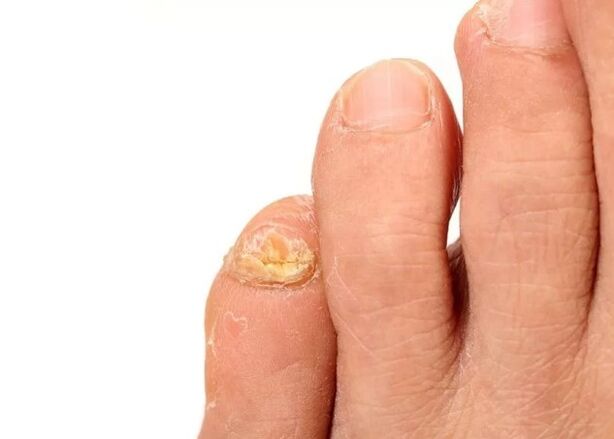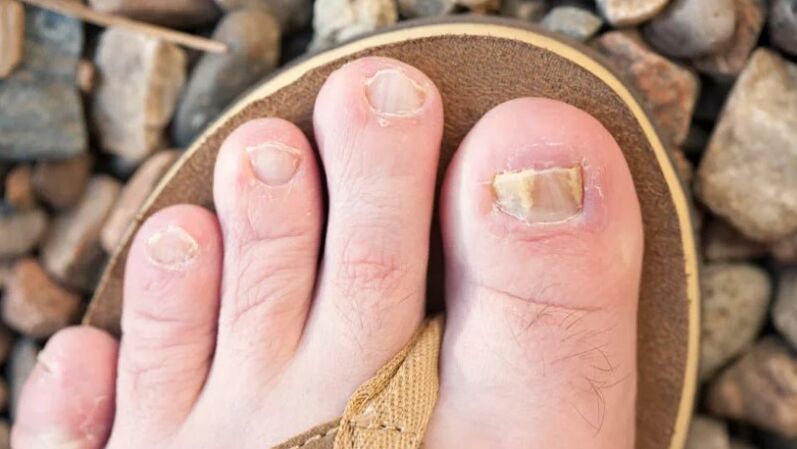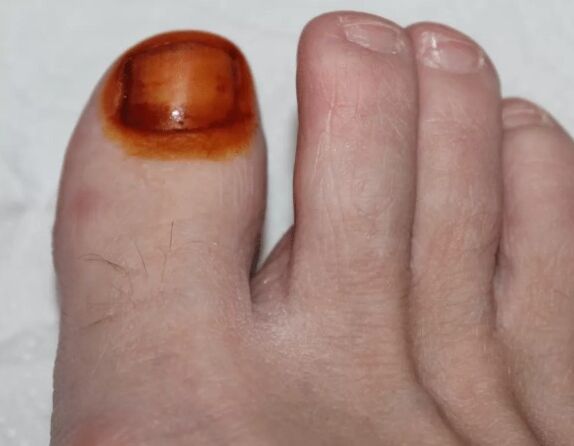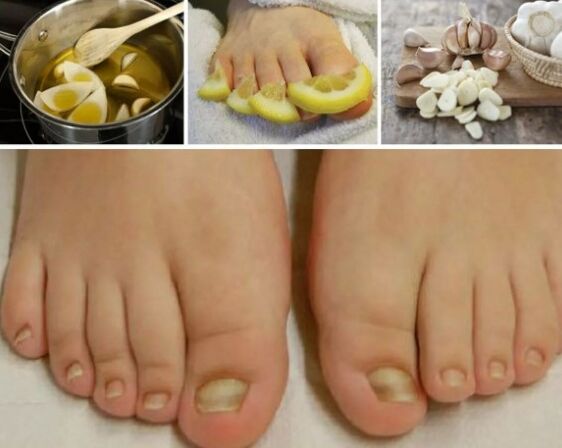According to statistics, almost half of all calls for a dermatologist, one way or another, is associated with fungal disease. You can put the infection when visiting the pool, the sauna, after visiting the beach or visiting the master slippers.
Learn everything about how to recognize the fungus of the nail fungus without fragmentation and the use of other diagnostic methods - the symptoms of manifestations of the initial and chronic phase of the disease.

Many do not even suspect that banal sweating of the feet, accompanied by an unpleasant odor, which suffers more than half of the population of our planet, is one of the main symptoms of nail fungus. This disease is at risk of getting sick who, at least little neglecting personal hygiene.
Nail mushrooms stay waiting everywhere, especially in places of public use. And the worst thing is that nail fungus is a very secret disease: its treatment is long, and not always successful, as mycosis is prone to relax.
To know the disease in time and to begin its treatment, you need to know all the signs of fungi in the legs.
How does the disease spread?
The infection is caused by parasitic fungi. An ideal environment for their reproduction and development is to increase moisture in combination with a warm atmosphere. It is generally acknowledged that the main places where the risk of infection with nail fungus is high is baths, saunas, water parks, pools, manicure salons, etc.
However, statistics completely reject the following statements: nail fungus can be taken at home through ordinary things (towels, shoes, clothes, carpets, shower or bathrooms), if one of the family members already has this problem, or at a party, for example, through slippers, well proposed by the owner (and he can not even suspect a disease (
But what factors affect the development of a fungal disease? They notice such basic moments, leading to infection with onychomycosis:

In order to at least partially protect yourself, you must use your things exclusively, treat the bathroom carefully and shower with antiseptic, use a personal towel, clean regularly and wash carpets, disinfect your shoes. And in order not to lose the favorable moment for the treatment of mycosis (after all, everyone knows that therapy is most effective in the initial stage of the disease development), you need to know the first signs of nail fungus.
Once you have known the first signs of nail fungus, you should contact a specialist immediately who will describe the optimal treatment regimen.
How do different types of onychomycosis appear?
3 types of onychomycosis are determined, each of which manifests itself in its signs.
You can determine the presence of a fungus on the nails yourself, but only a specialist can make an accurate diagnosis. To do this, you need to visit the clinic, get to analyze the fragmentation of a sore nail or skin located around it. Moreover, a dermatologist describes a microscopic or cultural study.
Signs of fungi from the pathogen of the disease
The success of treating nail fungus depends on how accurately the pathogen is diagnosed. This is explained by the fact that the disease does not cause a type of fungus, but some, and each of them is susceptible to certain medicines. That is to say, if one type of fungus is resistant to a medicine, then the other pathogen dies from this product.
Most often, nail fungus causes:

If the cause of the nail fungus became the top, then it is almost impossible to identify the disease immediately. Mushroom signs on the nails of the feet in this case are the following (they appear after a long period of time): peel from the nail plate and light itching of the skin near the nails (itching may be missing). Yeast failure infection occurs at 4-4. 5% of cases.
Dermatophytes affect a person's nails much more often than the previous pathogen - this is 94. 5% of all cases of nail infection with a fungus. Dermatophytes are of three types, each manifesting in different ways:
The last type of fungus is mold. Its pathogen is mold. This disease is found in only 1% of cases. A fungus of this species develops more often in people infected with HIV.
Other symptoms of fungal nail infection
Often at the beginning of the disease, visible signs of nail damage fungus are missing. However, to be careful, you may notice some changes in the nail structure and its appearance.
As mentioned earlier, longitudinal or round white spots can appear on the nail plate, the nail can be wireless, while its softness and shine are lost.
By progressing, the disease increasingly destroys the nail plate: first its shade changes, then the surface of the nail is scaled, thickened or thickened, relaxes, breaks. The color of the nail depends on the type of fungus became the causative agent of the infection.
In addition to the main signs of onycomycosis, there are others:

Deviationdo deviation in the appearance of nails in the legs should be alert, as this can indicate the development of nail fungus. The first action in this case is a trip to a dermatologist who will confirm or reject your fear. If this is not done immediately, the disease will progress.
At first glance, there is nothing wrong with this disease. However, in addition to purely aesthetic and discomfort problems, fungi can cause serious complications, up to the purulent infection of the affected areas and even the development of gangrene.
Therefore, do not tighten with treatment, take action immediately, after the disease was detected.
What looks like nail fungus
Any third person in the soil encounters a problem such as laying and peeling nails, clouding of the plate - this is onychomycosis. The disease affects different age groups. The nails of the nails (the photos appear below), quickly spreads and adapts to new conditions. We will consider in more detail the main factors of the occurrence, types and methods of fungal treatment.
What is nail fungus?
Onychomycosis is a pathology that destroys nail plates. The fungus eats keratin - the base of the nail construction. The infection falls into the intercellular space and begins its separation. In the advanced stages, the pathology is able to affect the skin of the feet, the interconnecting area.
Do not start the mushrooms and treat it immediately
Causes of nail fungus
One infected with onychomycosis is quite easy. The infection can fall on the beach, the public spirit, the pool. A high probability of catching a fungus from relatives or infected acquaintances (using ordinary lives).
There are some main prerequisites that can provoke the introduction of the virus into the human body:

Types of nail fungus
Onychomycosis can provoke several types of fungi. Dermatophytes, for example, appear in the new form of the nail. There is a formation of yellow spots along the edges or in the middle of the plate. Moreover, longitudinal stripes can be observed along the affected area.
In the late stages of nail fungus, surgical intervention may be required
Yeast mushrooms provoke deformation of the nail plate. She is very sophisticated and begins to leave her place, becomes gray. Metabolism in damaged cells worsens, the furrows appear on the nail roll. Moreover, inflammation, edema, redness appear in the adjacent epidermis, the disappearance of the nail skin is observed.
Mold bacteria can damage the nail plate if there are already diseases that provoke nail food disorders. In this case, there is also a cloud of tile, a change in its color (from light and green yellow to brown and even black).
To detect the cause and pathogen of negative changes in the skin and nails, you should contact a specialist. An independent determination of the disease and its treatment without consulting with a physician can be fraught with consequences.
Popular methods
Against fungal infection at an early stage of development, non -traditional agents may be used. The following are the most effective:

All folk remedies can only be used after consulting a dermatologist. Many are able to provoke allergic reactions. It is easier to cure onycomycosis by combining non -traditional medicines with medicines.
In the initial stage, the fungus on the foot looks like almost invisible grooves or white spots. Often a person learns about the presence of a fungus infection only during a visit to a dermatologist. This is due to the fact that it is almost impossible to recognize the disease during this period. If you start therapy in time, then the disease recover quickly.
















